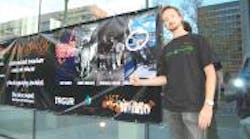“In many ways, the trucks I’m photographing are rapidly becoming relics of the past, due to business and regulatory pressures. That’s giving me a sense of urgency in what I’m doing; to capture a piece of the golden age of trucking before it disappears.” –Roger Snider, truck photographer extraordinaire
Roger Snider has graced this blog before and for good reason – his globe-trotting photographic sprees produce some of the most amazing shots of custom trucks you’ll ever see, in some truly eye-popping locales as well.
Roger (seen at right) recently wrapped up a three-nation whirlwind tour this year for his Ultra Rigs of the World endeavor, revisiting Japan in May, then travelling to Switzerland for a truck tour that took him to France and German as well. He then finished up this particular worldwide journey with a visit to Australia in August – largely focused on what’s dubbed “classic truck” enthusiasts in and around Alice Springs, home to the U.S. Army’s staging area in the Pacific Theatre back in World War II.
Believe it or not, Roger discerned a common theme running through these incredibly different trucking cultures on three continents: a hard-as-nails work ethic; a passion for truck customization that borders on craziness; and a deep, abiding love of the trucking lifestyle.
“Many of the people I talk with are living out their dreams,” Roger told me by phone from his home in Los Angeles. “They are also always trying to find ways to make their rigs look special, to make them unique. They really have no ‘off switch’ when it comes to their work and their trucks.”
[You can view a collection Roger’s work below in a “silent movie” style review of his many custom truck photographs.]
Yet the “artistic visions,” if you will, of custom truckers in these disparate parts of the world are very different – a byproduct, in many cases, of the economic, climatic, and regulatory realities imposed upon them in the countries where they live and work.
The truckers Roger met in Switzerland (and subsequently in France and Germany) all use the same aerodynamic cabover style of truck – vehicles configured to meet demanding European emission, weight, and dimension rules. He noted that American-style conventional simply could not survive in such an environment form an economic standpoint (much as the Europeans admire them).
Yet, though the truck brands the Europeans use – Scania, DAF, MAN, etc. – all tend to look the same, the custom truckers differentiate them through the use of murals. Such large scale, whole-truck paintings turn their tractor-trailers literally into giant rolling canvasses, said Snider, and definitely make each of them unique.
In Australia, however, different factors were at work. “Down under, the conditions these trucks operate in drive their design – and, consequently, their customization,” Roger told me. “The ‘road trains’ must be high off the ground, to give the trucks clearance over uneven terrain, numerous animals, and the thick ever-present clouds dust rolling along the outback.
“Trucks built low to the ground in ‘gangster’ style – which is becoming popular in the U.S. now – would not survive in these conditions,” Roger told me. “Consequently, most of the ‘classical’ customer truckers I met try to keep their rigs in line with ‘normal’ specs – jacked-up sleeper, air cleaners set high to avoid dust, etc. They also try to conform to original specs. That’s why there are a lot of older Macks out there that look like they just rolled off the production line.”
However, that being said, in the major cities like Melbourne the “gangster” style is catching on with local and regional truckers that stick to paved surfaces. “That’s a whole new segment of Australian truck culture I did not get to meet, so I’ll have to go back,” Roger noted with a laugh.
Yet the ever-increasing pressures on trucking’s bottom line – both in terms of business and regulatory costs – are forcing many custom truckers off the road in nations across the globe, Roger found, or at least back into non-descript vehicles that operate within the ever-tighter margins of the freight business.
“A lot of these stylistic vehicles are getting pulled from the road everywhere. They are rapidly becoming relics as often times it doesn’t make business sense to move loads with them,” he told me. “That’s why I have this sense of urgency in what I do. People really love these vehicles, but soon they’ll say ‘these were trucks that used to pull freight on the highway.’”
Still, Roger said he remains enthralled by these vehicles and their owners alike. “It’s one thing to look at these trucks in photographs – quite something else to see them in person,” he explained. “When I talk to the owners, they wonder why I am there to take photos of them and their equipment. I tell them it’s because they’ve created a piece of art; something unique that doesn’t anywhere else. That’s what I try to bring out in my photos.”
Roger also has several more trips planned in the months ahead – to Brazil, South Africa and hopefully New Zealand – so he can further expands his one-of-a-kind photographic record of custom trucks from around the world.
I for one can’t wait to see what he finds next.



